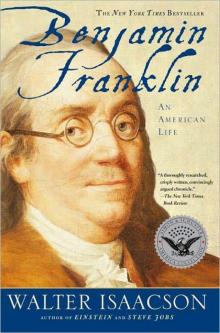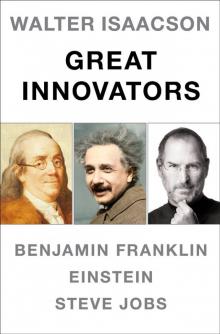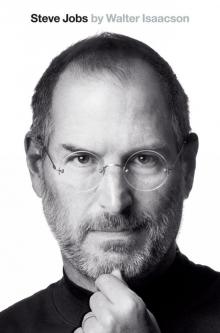- Home
- Walter Isaacson
Einstein: His Life and Universe
Einstein: His Life and Universe Read online
ALSO BY WALTER ISAACSON
A Benjamin Franklin Reader
Benjamin Franklin: An American Life
Kissinger: A Biography
The Wise Men: Six Friends and the World They Made (with Evan Thomas)
Pro and Con
EINSTEIN
HIS LIFE AND UNIVERSE
WALTER ISAACSON
SIMON & SCHUSTER
Rockefeller Center
1230 Avenue of the Americas
New York, NY 10020
www.SimonandSchuster.com
Copyright © 2007 by Walter Isaacson
All rights reserved,
including the right of reproduction
in whole or in part in any form.
Simon & Schuster and colophon are registered trademarks of Simon & Schuster, Inc.
For information about special discounts for bulk purchases, please contact Simon & Schuster Special Sales at 1-800-456-6798 or [email protected].
Endpapers: Alan Richards, Princeton University Library
Frontispiece: Ullstein Bilderdienst/The Granger Collection, New York
Illustration credits are on page 679.
Manufactured in the United States of America
10 9 8 7 6 5 4 3 2 1
Library of Congress Cataloging-in-Publication Data
Isaacson, Walter.
Einstein : his life and universe / Walter Isaacson.
p. cm.
Includes bibliographical references and index.
1. Einstein, Albert, 1879–1955. 2. Physicists—Biography. 3. Einstein, Albert, 1879–1955—Friends and associates. 4. Relativity (Physics). 5. Unified field theories. I. Title.
QC16.E5I76 2007
530.092—dc22
[B]
2006051264
ISBN-13: 978-0-7432-6473-0
ISBN-10: 978-0-7432-6473-8
eISBN-13: 978-1-4165-3932-2
To my father, the nicest, smartest, and most moral man I know
In Santa Barbara, 1933
Life is like riding a bicycle.
To keep your balance you must keep moving.
—ALBERT EINSTEIN, IN A LETTER TO HIS SON EDUARD, FEBRUARY 5, 19301
CONTENTS
Acknowledgments
Main Characters
CHAPTER ONE
The Light-Beam Rider
CHAPTER TWO
Childhood, 1879–1896
CHAPTER THREE
The Zurich Polytechnic, 1896–1900
CHAPTER FOUR
The Lovers, 1900–1904
CHAPTER FIVE
The Miracle Year: Quanta and Molecules, 1905
CHAPTER SIX
Special Relativity, 1905
CHAPTER SEVEN
The Happiest Thought, 1906–1909
CHAPTER EIGHT
The Wandering Professor, 1909–1914
CHAPTER NINE
General Relativity, 1911–1915
CHAPTER TEN
Divorce, 1916–1919
CHAPTER ELEVEN
Einstein’s Universe, 1916–1919
CHAPTER TWELVE
Fame, 1919
CHAPTER THIRTEEN
The Wandering Zionist, 1920–1921
CHAPTER FOURTEEN
Nobel Laureate, 1921–1927
CHAPTER FIFTEEN
Unified Field Theories, 1923–1931
CHAPTER SIXTEEN
Turning Fifty, 1929–1931
CHAPTER SEVENTEEN
Einstein’s God
CHAPTER EIGHTEEN
The Refugee, 1932–1933
CHAPTER NINETEEN
America, 1933–1939
CHAPTER TWENTY
Quantum Entanglement, 1935
CHAPTER TWENTY-ONE
The Bomb, 1939–1945
CHAPTER TWENTY-TWO
One-Worlder, 1945–1948
CHAPTER TWENTY-THREE
Landmark, 1948–1953
CHAPTER TWENTY-FOUR
Red Scare, 1951–1954
CHAPTER TWENTY-FIVE
The End, 1955
EPILOGUE
Einstein’s Brain and Einstein’s Mind
Sources
Notes
Index
ACKNOWLEDGMENTS
Diana Kormos Buchwald, the general editor of Einstein’s papers, read this book meticulously and made copious comments and corrections through many drafts. In addition, she helped me get early and complete access to the wealth of new Einstein papers that became available in 2006, and guided me through them. She was also a gracious host and facilitator during my trips to the Einstein Papers Project at Caltech. She has a passion for her work and a delightful sense of humor, which would have pleased her subject.
Two of her associates were also very helpful in guiding me through the newly available papers as well as untapped riches in the older archival material. Tilman Sauer, who likewise checked and annotated this book, in particular vetted the sections on Einstein’s quest for the equations of general relativity and his pursuit of a unified field theory. Ze’ev Rosenkranz, the historical editor of the papers, provided insights on Einstein’s attitudes toward Germany and his Jewish heritage. He was formerly curator of the Einstein archives at Hebrew University in Jerusalem.
Barbara Wolff, who is now at those archives at Hebrew University, did a careful fact-checking of every page of the manuscript, making fastidious corrections large and small. She warned that she has a reputation as a nitpicker, but I am very grateful for each and every nit she found. I also appreciate the encouragement given by Roni Grosz, the curator there.
Brian Greene, the Columbia University physicist and author of The Fabric of the Cosmos, was an indispensable friend and editor. He talked me through numerous revisions, honed the wording of the science passages, and read the final manuscript. He is a master of both science and language. In addition to his work on string theory, he and his wife, Tracy Day, are organizing an annual science festival in New York City, which will help spread the enthusiasm for physics so evident in his work and books.
Lawrence Krauss, professor of physics at Case Western Reserve and author of Hiding in the Mirror, also read my manuscript, vetted the sections on special relativity, general relativity, and cosmology, and offered many good suggestions and corrections. He, too, has an infectious enthusiasm for physics.
Krauss helped me enlist a protégé of his at Case, Craig J. Copi, who teaches relativity there. I hired him to do a thorough checking of the science and math, and I am grateful for his diligent edits.
Douglas Stone, professor of physics at Yale, also vetted the science in the book. A condensed matter theorist, he is writing what will be an important book on Einstein’s contributions to quantum mechanics. In addition to checking my science sections, he helped me write the chapters on the 1905 light quanta paper, quantum theory, Bose-Einstein statistics, and kinetic theory.
Murray Gell-Mann, winner of the 1969 Nobel Prize in physics, was a delightful and passionate guide from the beginning to the end of this project. He helped me revise early drafts, edited and corrected the chapters on relativity and quantum mechanics, and helped draft sections that explained Einstein’s objections to quantum uncertainty. With his combination of erudition and humor, and his feel for the personalities involved, he made the process a great joy.
Arthur I. Miller, emeritus professor of history and philosophy of science at University College, London, is the author of Einstein, Picasso and of Empire of the Stars. He read and reread the versions of my scientific chapters and helped with numerous revisions, especially on special relativity (about which he wrote a pioneering book), general relativity, and quantum theory.
Sylvester James Gates Jr., a p
hysics professor at the University of Maryland, agreed to read my manuscript when he came out to Aspen for a conference on Einstein. He did a comprehensive edit filled with smart comments and rephrasing of certain scientific passages.
John D. Norton, a professor at the University of Pittsburgh, has specialized in tracing Einstein’s thought process as he developed both special and then general relativity. He read these sections of my book, made edits, and offered useful comments. I am also grateful for guidance from two of his fellow scholars specializing in Einstein’s development of his theories: Jürgen Renn of the Max Planck Institute in Berlin and Michel Janssen of the University of Minnesota.
George Stranahan, a founder of the Aspen Center for Physics, also agreed to read and review the manuscript. He was particularly helpful in editing the sections on the light quanta paper, Brownian motion, and the history and science of special relativity.
Robert Rynasiewicz, a philosopher of science at Johns Hopkins, read many of the science chapters and made useful suggestions about the quest for general relativity.
N. David Mermin, professor of theoretical physics at Cornell and author of It’s About Time: Understanding Einstein’s Relativity, edited and made corrections to the final version of the introductory chapter and chapters 5 and 6 on Einstein’s 1905 papers.
Gerald Holton, professor of physics at Harvard, has been one of the pioneers in the study of Einstein, and he is still a guiding light. I am deeply flattered that he was willing to read my book, make comments, and offer generous encouragement. His Harvard colleague Dudley Herschbach, who has done so much for science education, also was supportive. Both Holton and Herschbach made useful comments on my draft and spent an afternoon with me in Holton’s office going over suggestions and refining my descriptions of the historical players.
Ashton Carter, professor of science and international affairs at Harvard, kindly read and checked an early draft. Columbia University’s Fritz Stern, author of Einstein’s German World, provided encouragement and advice at the outset. Robert Schulmann, one of the original editors at the Einstein Papers Project, did likewise. And Jeremy Bernstein, who has written many fine books on Einstein, warned me how difficult the science would be. He was right, and I am grateful for that as well.
In addition, I asked two teachers of high school physics to give the book a careful reading to make sure the science was correct, and also comprehensible to those whose last physics course was in high school. Nancy Stravinsky Isaacson taught physics in New Orleans until, alas, Hurricane Katrina gave her more free time. David Derbes teaches physics at the University of Chicago Lab School. Their comments were very incisive and also aimed at the lay reader.
There is a corollary of the uncertainty principle that says that no matter how often a book is observed, some mistakes will remain. Those are my fault.
It also helped to have some nonscientific readers, who made very useful suggestions from a lay perspective on parts or all of the manuscript. These included William Mayer, Orville Wright, Daniel Okrent, Steve Weisman, and Strobe Talbott.
For twenty-five years, Alice Mayhew at Simon & Schuster has been my editor and Amanda Urban at ICM my agent. I can imagine no better partners, and they were again enthusiastic and helpful in their comments on the book. I also appreciate the help of Carolyn Reidy, David Rosenthal, Roger Labrie, Victoria Meyer, Elizabeth Hayes, Serena Jones, Mara Lurie, Judith Hoover, Jackie Seow, and Dana Sloan at Simon & Schuster. For their countless acts of support over the years, I am also grateful to Elliot Ravetz and Patricia Zindulka.
Natasha Hoffmeyer and James Hoppes translated for me Einstein’s German correspondence and writing, especially the new material that had not yet been translated, and I appreciate their diligence. Jay Colton, who was photo editor for Time’s Person of the Century issue, also did a creative job tracking down pictures for this book.
I had two and a half other readers who were the most valuable of all. The first was my father, Irwin Isaacson, an engineer who instilled in me a love of science and is the smartest teacher I’ve ever had. I am grateful to him for the universe that he and my late mother created for me, and to my brilliant and wise stepmother, Julanne.
The other truly valuable reader was my wife, Cathy, who read every page with her usual wisdom, common sense, and curiosity. And the valuable half-a-reader was my daughter,Betsy, who as usual read selected portions of my book. The surety with which she made her pronouncements made up for the randomness of her reading. I love them both dearly.
MAIN CHARACTERS
MICHELE ANGELO BESSO (1873–1955). Einstein’s closest friend. An engaging but unfocused engineer, he met Einstein in Zurich, then followed him to work at the Bern patent office. Served as a sounding board for the 1905 special relativity paper. Married Anna Winteler, sister of Einstein’s first girlfriend.
NIELS BOHR (1885–1962). Danish pioneer of quantum theory. At Solvay conferences and subsequent intellectual trysts, he parried Einstein’s enthusiastic challenges to his Copenhagen interpretation of quantum mechanics.
MAX BORN (1882–1970). German physicist and mathematician. Engaged in a brilliant, intimate correspondence with Einstein for forty years. Tried to convince Einstein to be comfortable with quantum mechanics; his wife, Hedwig, challenged Einstein on personal issues.
HELEN DUKAS (1896–1982). Einstein’s loyal secretary, Cerberus-like guard, and housemate from 1928 until his death, and after that protector of his legacy and papers.
ARTHUR STANLEY EDDINGTON (1882–1944). British astrophysicist and champion of relativity whose 1919 eclipse observations dramatically confirmed Einstein’s prediction of how much gravity bends light.
PAUL EHRENFEST (1880–1933). Austrian-born physicist, intense and insecure, who bonded with Einstein on a visit to Prague in 1912 and became a professor in Leiden, where he frequently hosted Einstein.
EDUARD EINSTEIN (1910–1965). Second son of Mileva Mari and Einstein. Smart and artistic, he obsessed about Freud and hoped to be a psychiatrist, but he succumbed to his own schizophrenic demons in his twenties and was institutionalized in Switzerland for much of the rest of his life.
ELSA EINSTEIN (1876–1936). Einstein’s first cousin, second wife. Mother of Margot and Ilse Einstein from her first marriage to textile merchant Max Löwenthal. She and her daughters reverted to her maiden name, Einstein, after her 1908 divorce. Married Einstein in 1919. Smarter than she pretended to be, she knew how to handle him.
HANS ALBERT EINSTEIN (1904–1973). First son of Mileva Mari and Einstein, a difficult role that he handled with grace. Studied engineering at Zurich Polytechnic. Married Frieda Knecht (1895–1958) in 1927. They had two sons, Bernard (1930–) and Klaus (1932–1938), and an adopted daughter, Evelyn (1941–). Moved to the United States in 1938 and eventually became a professor of hydraulic engineering at Berkeley. After Frieda’s death, married Elizabeth Roboz (1904–1995) in 1959. Bernard has five children, the only known great-grandchildren of Albert Einstein.
HERMANN EINSTEIN (1847–1902). Einstein’s father, from a Jewish family from rural Swabia. With his brother Jakob, he ran electrical companies in Munich and then Italy, but not very successfully.
ILSE EINSTEIN (1897–1934). Daughter of Elsa Einstein from her first marriage. Dallied with adventurous physician Georg Nicolai and in 1924 married literary journalist Rudolph Kayser, who later wrote a book on Einstein using the pseudonym Anton Reiser.
LIESERL EINSTEIN (1902–?). Premarital daughter of Einstein and Mileva Mari. Einstein probably never saw her. Likely left in her Serbian mother’s hometown of Novi Sad for adoption and may have died of scarlet fever in late 1903.
MARGOT EINSTEIN (1899–1986). Daughter of Elsa Einstein from her first marriage. A shy sculptor. Married Russian Dimitri Marianoff in 1930; no children. He later wrote a book on Einstein. She divorced him in 1937, moved in with Einstein at Princeton, and remained at 112 Mercer Street until her death.
MARIA “MAJA” EINSTEIN (1881–1951). Einstein’s only sibling, and among hi
s closest confidantes. Married Paul Winteler, had no children, and in 1938 moved without him from Italy to Princeton to live with her brother.
PAULINE KOCH EINSTEIN (1858–1920). Einstein’s strong-willed and practical mother. Daughter of a prosperous Jewish grain dealer from Württemberg. Married Hermann Einstein in 1876.
ABRAHAM FLEXNER (1866–1959). American education reformer. Founded the Institute for Advanced Study in Princeton and recruited Einstein there.
PHILIPP FRANK (1884–1966). Austrian physicist. Succeeded his friend Einstein at German University of Prague and later wrote a book about him.

 Benjamin Franklin: An American Life
Benjamin Franklin: An American Life Einstein: His Life and Universe
Einstein: His Life and Universe Walter Isaacson Great Innovators e-book boxed set
Walter Isaacson Great Innovators e-book boxed set Steve Jobs
Steve Jobs The Innovators
The Innovators A Benjamin Franklin Reader
A Benjamin Franklin Reader